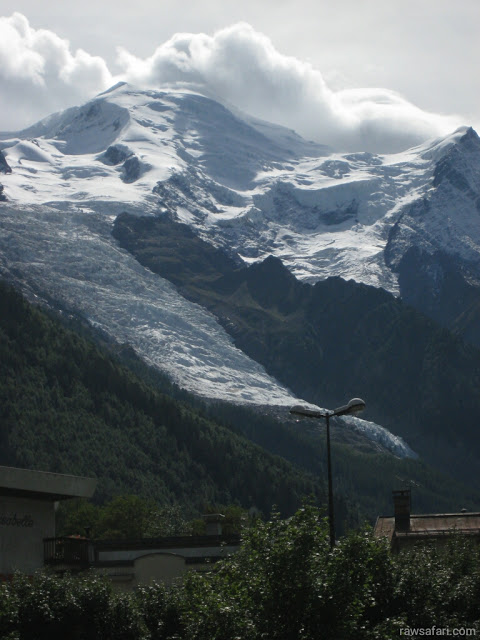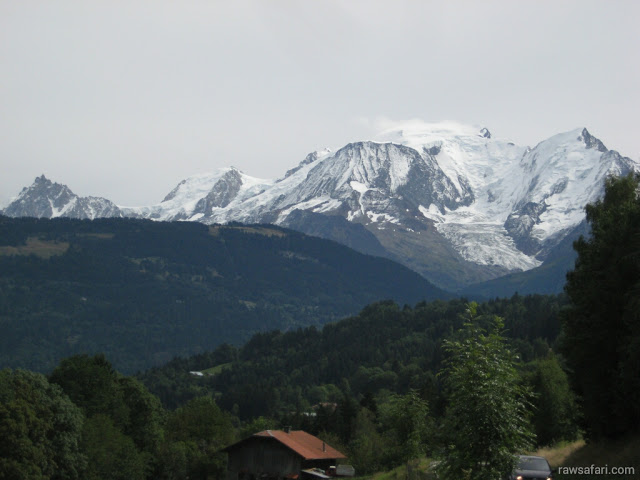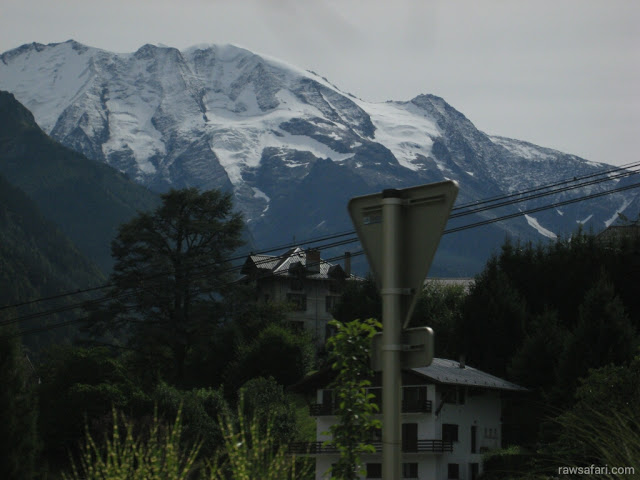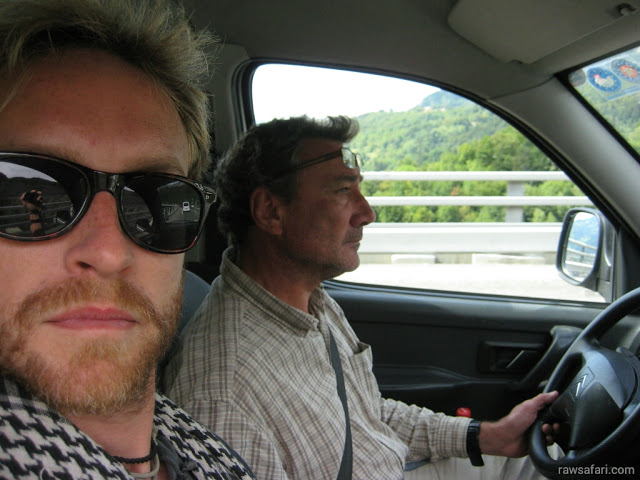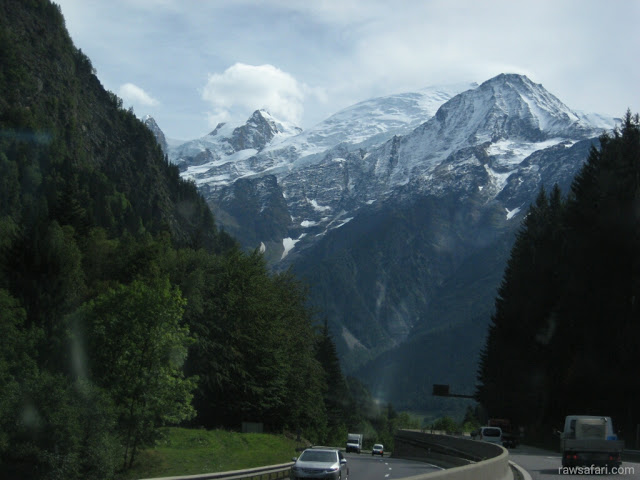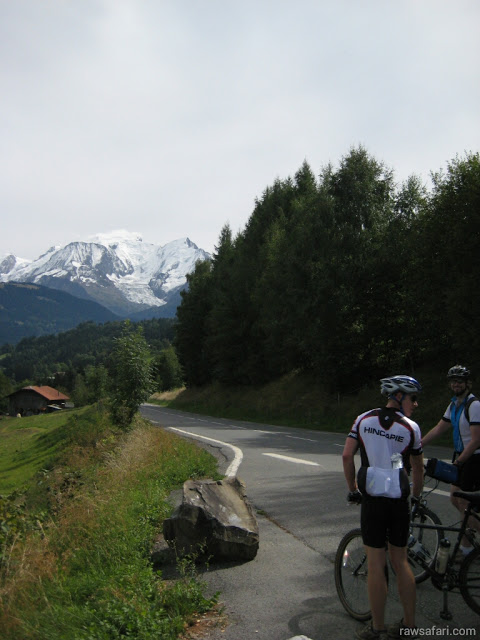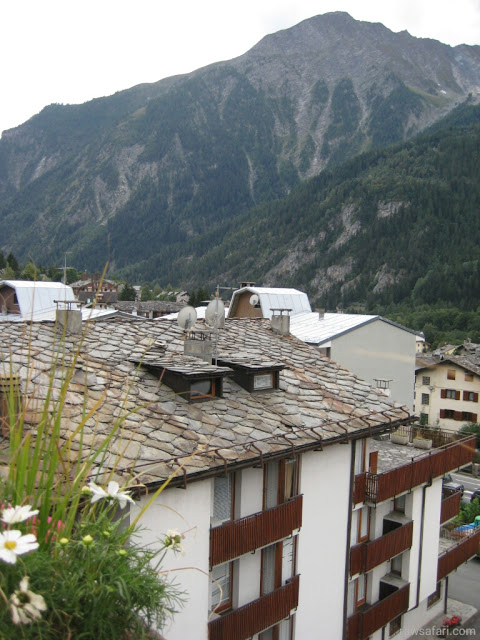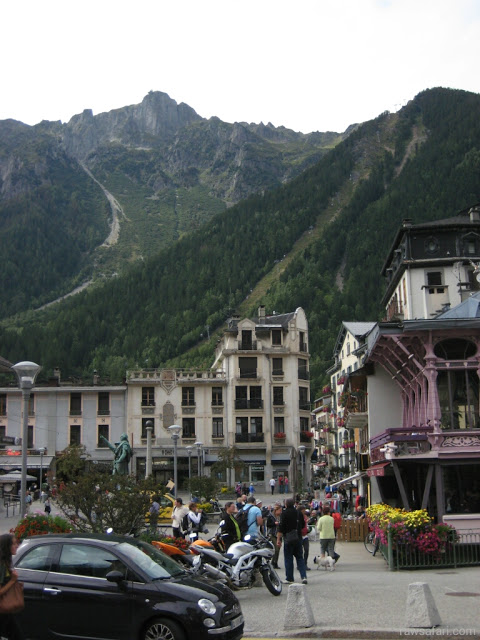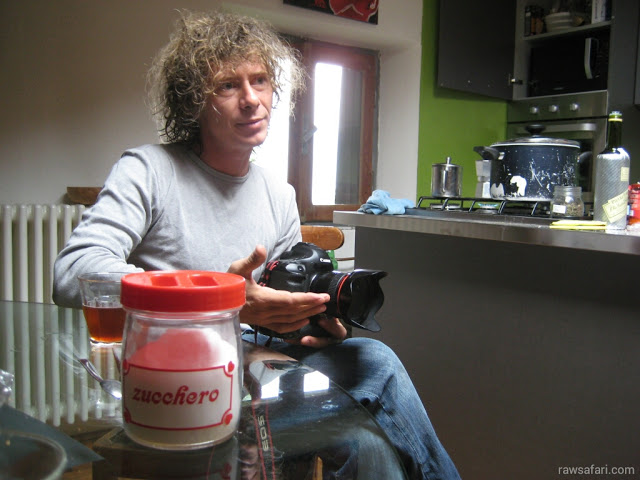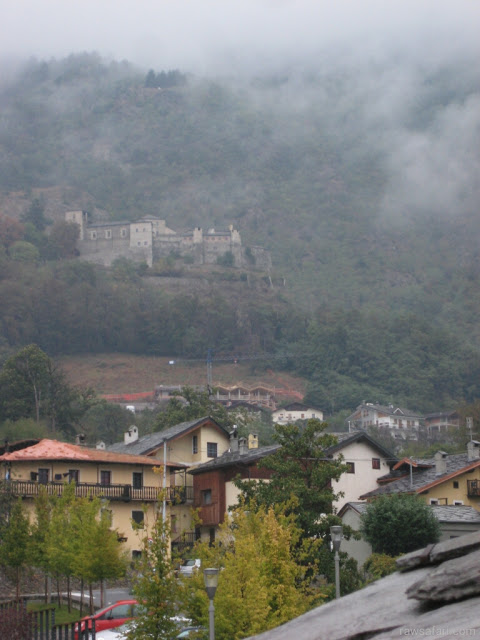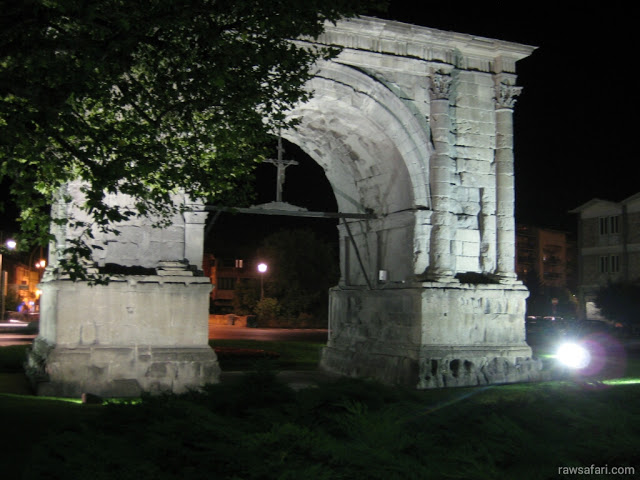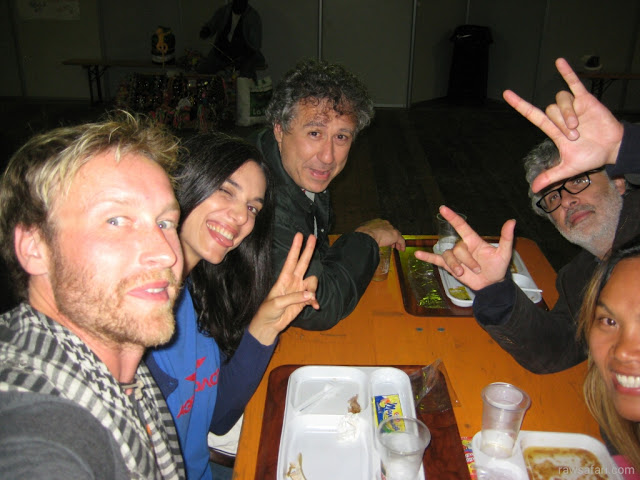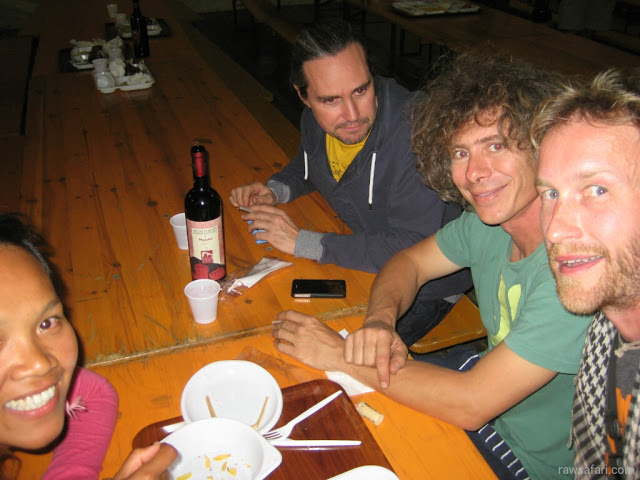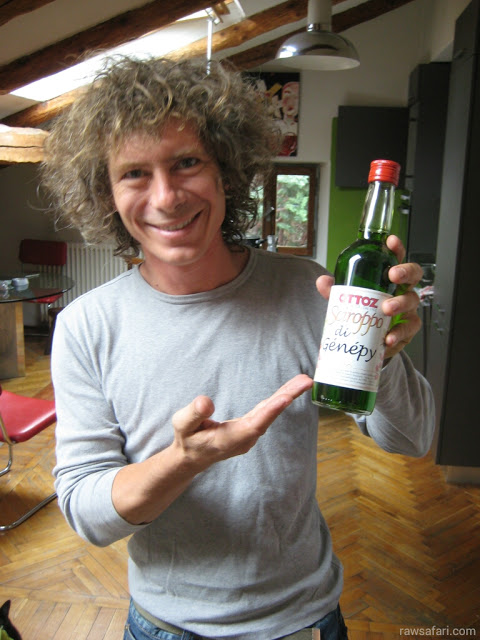…Italian people consider hitching old fashioned, associate it with the hippy era and rarely give rides. Italians do not hitchhike themselves and consider hitchhikers to be dangerous…
The further south we go in France the slower we move. The cars get more expensive and the rides sparser.
A guy stops for us and he is so drunk he hits the curb and blows out his tire. I help him repair it and offer to drive, but he gets indignant and drives off.
We crawl toward the Italian border, and the Alps begin to loom on the horizon, jagged and soaring.
(Above: the Mont-Blanc glacier reaching down toward Chamonix. This is the view from McDonalds. )
Eric picks us up and tells us he is going to Switzerland, but he can take us as far as Mont Blanc.
Eric is a handsome, suntanned man in his fifties or sixties, with a lean, charismatic face. He is a mountaineer and instructor, who works at a resort guiding trekkers in the alps. We speed along the narrow roads into the foothills in Eric’s grumbling old station wagon, and he tells us about the history of the region.
(White knuckles in Eric’s mountaineering station wagon.)
(Mont Blanc / Monte Bianco.)
(“Low income housing” French Alps style.)
(Chamonix.)
Mont Blanc has long been a disputed border region. France and Italy are still battling each other in the international court over the exact position of the border.
“The Italians say it is at the peak of Mont Blanc”, Eric explains, “but we French say it is 200 meters over the other side. Mont Blanc is French.”
The alps were long part of a kingdom which stretched from Lyon in the west to Torino in the east. When Napoleon was putting together his empire in the mid 1700’s he annexed the alps into France. The population were given an opportunity to be Italian, in a referendum in the 19th century, but voted overwhelmingly to stay French.
We see the slopes of Mont Blanc for the first time as we round a corner on a steep road, and leave the darkness of a tunnel. The pristine whiteness of the glacier, and the halo like “hat cloud” that crowns the peak make the mountain a spectacular sight.
Eric clearly loves the mountain. he spends most of his working life on Mont Blanc’s slopes, and his passion for its beauty and wildness is inspiring and infectious.
As we drive through the posh looking chalet villages Eric jokes that the ostentatious new buildings lining the road are “low income housing”. The really rich people live further up, and further from the highway. “The Hollywood actors go to the resorts. The roads here are too narrow for limousines.”
“This is the epicentre of Europe’s alpine culture” Eric tells us. “To the north, just 2 hours, is Switzerland, to the east, the Italian alps.”
Eric drops us at a small town called Chamonix, cradled in the highest of the Mont Blanc valleys. All around us the peaks of the alps tower above the town, and to the west, sparkling in the sunlight, the Mont Blanc peak itself rises precipitously. The major glacier snakes down the slope toward the town square in a quite unsettling way. Eric tells us that in the early 1800’s, the glacier was reported to be encroaching on the edge of the town.
We sit in the park and have our lunch and watch rich people. This is the summer, so the weather is warm, and there is no skiing. There are countless hang gliders circling the mountain, though, and many tanned athletic looking people in $1000 North Face outfits, riding bikes, sipping coffee and cruising the strip in sports cars.
After lunch we borrow some WiFi in a McDonalds with a ten million dollar view, and head for the road to Italy.
From Chamonix on the French side of Mont Blanc, to Courmayeur, Monta Bianco, Italy, there is a 13km tunnel directly under the mountain. We wait patiently for nearly 2 hours at the tunnel gate, but the traffic is very slow because of the summer. A lady from the tunnel control office approaches us and I smile tiredly, waiting for the bum’s rush.
“It is slow today, no?” she asks. “One of our guys is going across to Italy in half an hour, you can go with him if you like”. We thank her enthusiastically, and she tells us to wait in the office, and gives us tokens for the staff coffee machine.
Nicholo is an Italian rescue technician who works in the tunnel control office during the summer. He drives us to the Italian side of the tunnel and we pick his brain about useful Italian phrases:
Grazia = thank you
Ciao = hello
Service station = benzin aio
Entry ramp = entrata (“don’t hitch there” he warns us, the Italian Polizia are even more unforgiving than the Gendarmes.)
Toll booth = check
Hitchhike = auto stop
yes = Si
No = no (easy)
supermarket = supermarket (this Italian is a doddle)
please = por favori (accompanied with suitably supplicating hand gestures)
We emerge from the tunnel in Italy. The view of the valley below is “molto benne!”
Nicholo takes us into Courmayeur, an Italian chalet town which is also crawling with North Face models, but noticeably rustier and less prosperous looking than French Chamonix. We notice a couple of boarded up hotels on the main street. If the night is really cold and we don’t get a ride, we can sleep in an abandoned 4 star hotel.
Along the main street there is a red carpet rolled out. We feel very happy to be getting this treatment, but then we realise it actually for the competitors in a race, the “Tor Des Geants” which has just concluded. The Tor des Geants, (Tour of Giants) is an ultra marathon for mountain trekkers. The competitors walk across a punishing course through the alps to Cormayeur, where they are greated with a red carpet.
I flick through the Wikitravel article on Italy as we walk down the hill to a service station (benzin aio). One phrase jumps out at me:
“Italy is harder to hitchhike than probably anywhere else in Europe… Italian people consider hitching old fashioned, associate it with the hippy era and rarely give rides. Italians do not hitchhike themselves and consider hitchhikers to be dangerous.”
We buy a map at the benzin aio, drop our bags next to the narrow road, take a deep breath, and stick our thumbs out. A 4×4 pick-up approaches, slows and stops. A smiling man with a mop of curly blonde hair calls out “Bonjourno! Get in!” We get our first ride in Italy in 30 seconds.
Pietro is a photographer who has just finished covering the Tor des Geants race. He is heading home for some R+R after a week in the alps, scrambling around chasing trekkers up and down cliffs and glaciers.
“I am very tired”, Pietro tells us, “but you are welcome to stay tonight in my home. It is very messy, and I am too tired to be a good host but, you are welcome.”
We accept gratefully, and Pietro drives us to his attic apartment in the foothills.
After a cigarette and a glass of wine or two, Pietro is much revived, and tells us we will go out and meet some friends for a quiet drink.
We all pile into the truck, and bounce down the cobbled roads to the nearby village, where the night life is in full swing. It is the festival night of the village Patron Saint, an there is a band, dancing, and a food tent serving delicious looking local specialties.
In the square there is a roman arch, which Pietro tells us is about 2000 years old. I touch it in awe. My first Roman relic in the wild.
We sit under a canopy with Pietro and his friends, a cheerful, very friendly group, who luckily for us speak very good English. Pietro brings local wine to the table, and a large plate of food, and we are all soon chewing happily, and swaying to the sounds of the raucous polka band playing in the tent next door. Elderly people are dancing politely together. Kids are hanging around in the darkness, laughing and flirting. The atmosphere is warm, welcoming, and unpretentious, and the music is irresistibly energetic and flamboyant. Our new friends tell us that the music is the regions own special flavour. It is part latin, part germanic folk, and all glam. I can imagine the band playing at a noisy wedding party. Pietro confesses he is not a fan of the music but loves the party because of the food and wine.
We eat “stinco”, savoury roast pork shin on the bone, and a creamy pasta dish, and wash it down with a sharp, dry, red wine. After the meal we drink more wine, an Pietro orders a plate of fresh prosciutto, sliced straight from the joint.
Around midnight, we tumble into bed at Pietro’s, tired, happy, and thankful we pay no attention to guide books.
(The view from Pietro’s attic guest room.)
(My first Roman ruins in the wild.)
(Fiesta!)
(A souvenir from Pietro : it’s green it’s Italian and its 40%.)
